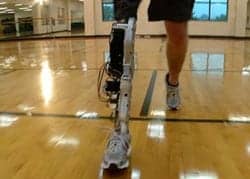
Previously, Goldfarb’s team developed a robotic prosthesis with both powered knee and ankle joints. According to Vanderbilt University, the design became the first artificial leg controlled by thought when Rehabilitation Institute of Chicago researchers created a neural interface for it.
A news release from the university states that in the current article the researchers, Goldfarb, and graduate students Brian Lawson and Amanda Shultz, describe these current technological advances, which include lithium-ion batteries that can store more electricity, powerful brushless electric motors with rare-Earth magnets, miniaturized sensors built into semiconductor chips, particularly accelerometers and gyroscopes, and lower-power computer chips.
Thanks to their size and weight, the researchers say, these components can be combined into a package comparable to that of a biological leg and can duplicate all of its basic functions. While the motors power movement, the batteries can store enough power so the robotic legs can reportedly operate for a full day on a single charge. Sensors assist by providing information such as the angle between the thigh and lower leg and the force being exerted on the bottom of the foot. The release adds that a microprocessor offers coordination function and a neural interface enhances integration with the brain.
The researchers also note in the release that robotic legs have the ability to move independently and out of sync with its user’s movements. This calls for the development of a system that integrates the movement of the prosthesis with the movement of the users, which is “substantially more important with a robotic leg.” The researchers add that the identification of the user’s intent (such as moving from walking to stair climbing) hinges on some connection with the nervous system.
Several approaches reportedly exist to establish a connection between the user’s intent and the central nervous system. The least invasive involves the use of physical sensors that define the user’s intent through his or her body language. The electromyography interface, a second method, uses electrodes implanted into the user’s leg muscles. Additional and more invasive techniques involve implanting electrodes directly into a patient’s peripheral nerves or directly into the brain.
In the release, the authors highlight the benefits of bionic legs, stating that many studies indicate users equipped with the lower-leg prostheses with powered knee and heel joints naturally walk faster with decreased hip effort while expending less energy when they are using passive prostheses.
The authors also emphasize the potential for robotic prosthesis to decrease the rate of falls among amputees, including the ability to program active responses into the robotic leg to assist in recovery from stumbles and not having to compensate for deficiencies in the robotic leg’s movement as a user might for passive legs. However, the article notes that the US Food and Drug Administration (FDA) must first approve these devices prior to patient use.
In the article, the authors also point to the necessity for additional training for clinicians who prescribe prostheses, noting that this training will need to be established and completed prior to robotic prostheses becoming viable products. The additional training is necessary, the authors explain, as the new devices are more complex than standard prostheses.
[Photo Credit: John Russell/Vanderbilt]
[Source: Vanderbilt University]



